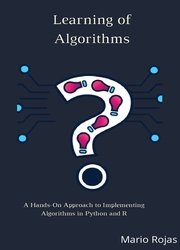 Название: Learning of Algorithms: A Hands-On Approach to Implementing Algorithms in Python and R
Название: Learning of Algorithms: A Hands-On Approach to Implementing Algorithms in Python and RАвтор: Mario Rojas
Издательство: Amazon.com Services LLC
Год: 2021
Страниц: 403
Язык: английский
Формат: pdf, azw3, epub
Размер: 32.0 MB
Machine learning can be broadly classified into supervised and unsupervised learning. By definition, the term supervised means that the “machine” (the system) learns with the help of something—typically a labeled training data. Training data (or a dataset ) is the basis on which the system learns to infer. An example of this process is to show the system a set of images of cats and dogs with the corresponding labels of the images (the labels say whether the image is of a cat or a dog) and let the system decipher the features of cats and dogs.
Similarly, unsupervised learning is the process of grouping data into similar categories. An example of this is to input into the system a set of images of dogs and cats without mentioning which image belongs to which category and let the system group the two types of images into different buckets based on the similarity of images.
There are two major types of unsupervised techniques:
- Clustering-based approach
- Principal components analysis (PCA)
Clustering is an approach where rows are grouped, and PCA is an approach where columns are grouped. We can think of clustering as being useful in assigning a given customer into one or the other group (because each customer typically represents a row in the dataset), whereas PCA can be useful in grouping columns (alternatively, reducing the dimensionality/variables of data).
In this book, we will be dealing with a majority of supervised and unsupervised algorithms as follows:
1. We first hand-code them in Excel.
2. We implement in R.
3. We implement in Python.
The basics of Excel, R and Python are outlined in the appendix.
Скачать Learning of Algorithms